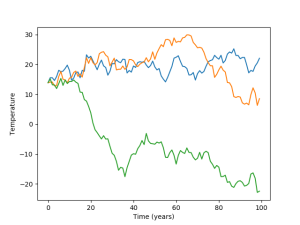Propagation of Error and the Reliability of Global Air Temperature Projections, Mark II.
Propagation of nonsense – part II
I thought I would look again at Pat Frank’s paper that we discussed in the previous post. Essentially Pat Frank argues that the surface temperature evolution under a change in forcing can be described as
where  is an enhancement factor that amplifies the GHG-driven warming,
is an enhancement factor that amplifies the GHG-driven warming,  is the total greenhouse gas forcing,
is the total greenhouse gas forcing,  is the incremental change in forcing, and
is the incremental change in forcing, and  is the unperturbed temperature (which I’ve taken to be 0).
is the unperturbed temperature (which I’ve taken to be 0).
Pat Frank then assumes that there is an uncertainty,  , that can be propagated in the following way
, that can be propagated in the following way
which assumes an uncertainty in each time step of  and leads to an overall uncertainty that grows with time, reaching very large values within a few decades.
and leads to an overall uncertainty that grows with time, reaching very large values within a few decades.
 Since I’m just a simple computational physicist (who is clearly has nothing better to do than work through silly papers) I thought I would code this up. That way I can simply run the simulation many times to try and determine the uncertainty. Since it’s not quite clear which term the uncertainty applies to, I thought I would start by assuming that it applies to
Since I’m just a simple computational physicist (who is clearly has nothing better to do than work through silly papers) I thought I would code this up. That way I can simply run the simulation many times to try and determine the uncertainty. Since it’s not quite clear which term the uncertainty applies to, I thought I would start by assuming that it applies to
The result is shown in the figure on the upper right. I ran a total of 300 simulations, and there is clearly a range that increases with time, but it’s nothing like what is presented in Pat Frank’s paper. This range is also really a consequence of the variation in  ultimately being a variation in climate sensitivity.
ultimately being a variation in climate sensitivity.
 The next thing I can do is assume that the
The next thing I can do is assume that the  Given that in any realistic scenario, the annual change in radiative forcing is going to be much less than
Given that in any realistic scenario, the annual change in radiative forcing is going to be much less than
Pat Frank’s analysis essentially suggests that adding energy to the system could lead to cooling. I’m pretty sure that this is physically impossible. Anyway, I think we all probably know that Pat Frank’s analysis is nonsense. Hopefully this makes that a little more obvious.
